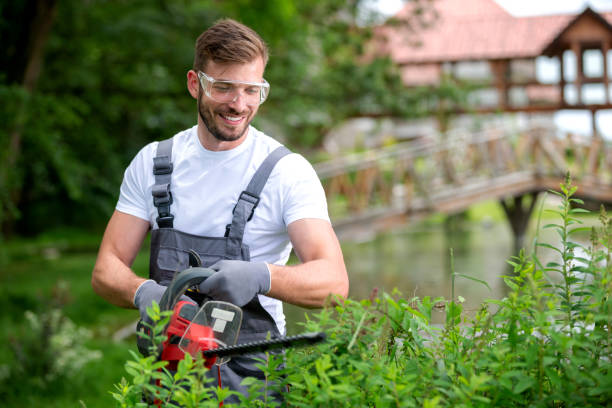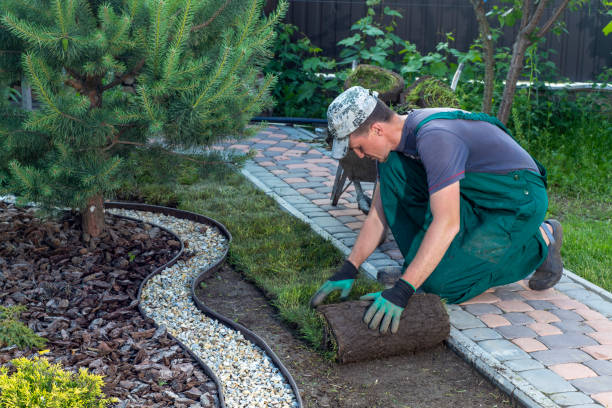εισαγωγή
Περισσότερο από την απλή τοποθέτηση φυτών και λίθων στα σωστά σημεία, ο εξωραϊσμός είναι μια καλαίσθητη συγχώνευση επιστημονικών εννοιών και καλλιτεχνικής έκφρασης. Ο βασικός στόχος του εξωραϊσμού είναι να κάνει τους εξωτερικούς χώρους πιο όμορφους αισθητικά διατηρώντας παράλληλα τη χρησιμότητα και τη βιωσιμότητά τους. Η γνώση των βασικών στοιχείων του τοπίου είναι ζωτικής σημασίας για την κατασκευή όμορφων εξωτερικών χώρων που διαρκούν μια ζωή, είτε σχεδιάζετε έναν μεγάλο κήπο είτε μια μικρή απόδραση στην πίσω αυλή.
Η αξία της έμπειρης εξωραϊσμός

Ένας αυξανόμενος αριθμός ιδιοκτητών σπιτιού μεταμορφώνουν τους εξωτερικούς τους χώρους με τη βοήθεια επαγγελματιών τοπιολόγων στο σημερινό περιβάλλον με γρήγορους ρυθμούς. Οι επαγγελματίες τοπιογράφοι εγγυώνται ότι το έργο εξωραϊσμού σας ξεπερνά τις προσδοκίες φέρνοντας την εμπειρία, τη φαντασία και τη γνώση του κλάδου στο τραπέζι. Η πρόσληψη ενός επαγγελματία σκηνοθέτη μπορεί να σας βοηθήσει να αποφύγετε τη σπατάλη χρόνου και χρημάτων ή να επιδεινώσετε τον εαυτό σας με δουλειές που πηγαίνουν στραβά, από τον προγραμματισμό μέχρι την ολοκλήρωση.
Αρχές Σχεδιασμού Τοπίου
Μερικές θεμελιώδεις έννοιες —όπως η ενότητα, η εξωραϊσμός εστίαση, η ισορροπία και η αναλογία— είναι απαραίτητες για καλό σχεδιασμό τοπίου. Οι τοπιογράφοι παράγουν οπτικά ευχάριστες συνθέσεις, εμπνέουν μια αίσθηση αρμονίας και αιχμαλωτίζουν την προσοχή εναρμονίζοντας προσεκτικά πτυχές όπως το χρώμα, η υφή και το σχήμα. Ενώ η ενότητα παράγει ένα συνεκτικό σχέδιο που ρέει φυσικά από τη μια περιοχή στην άλλη, η αναλογία διασφαλίζει ότι κάθε στοιχείο του τοπίου αλληλεπιδρά με τη συνολική επιφάνεια με αρμονικό τρόπο. Δίνοντας έμφαση σε σημαντικές λεπτομέρειες ή σημεία εστίασης, η εστίαση δίνει στο τοπίο περισσότερο βάθος και οπτική ελκυστικότητα.
Αξιολόγηση του εξωτερικού σας χώρου
Είναι σημαντικό να αξιολογήσετε σε βάθος την εξωτερική σας περιοχή πριν ξεκινήσετε οποιαδήποτε έργα εξωραϊσμού. Λάβετε υπόψη το κλίμα, την ποιότητα του εδάφους, την ποσότητα της ηλιοφάνειας και τη βλάστηση στην περιοχή. Μπορείτε να επιλέξετε φυτά, υλικά με σκληρό τοπίο και σχεδιασμό διάταξης πιο σοφά εάν γνωρίζετε τις ιδιαίτερες ιδιότητες της τοποθεσίας σας. Επιπλέον, η διεξαγωγή έρευνας τοποθεσίας σάς δίνει τη δυνατότητα να αναγνωρίσετε τυχόν εμπόδια και πλεονεκτήματα, διασφαλίζοντας ότι η προσπάθεια εξωραϊσμού σας είναι πρακτικά υγιής και οπτικά όμορφη.
Επιλέγοντας τα σωστά εξωραϊσμός φυτά

Η κατάλληλη επιλογή φυτών είναι απαραίτητη για μια επιτυχημένη προσπάθεια εξωραϊσμού. Όταν επιλέγετε φυτά για τον εξωτερικό σας χώρο, λάβετε υπόψη πράγματα όπως ο τύπος του εδάφους, οι απαιτήσεις σε νερό, η κλιματική συμβατότητα και οι απαιτήσεις συντήρησης. Δεδομένου ότι τα ιθαγενή φυτά έχουν εγκλιματιστεί στο περιβάλλον της περιοχής και απαιτούν λίγη συντήρηση μόλις εγκατασταθούν, είναι συχνά μια εξαιρετική επιλογή. Μια ποικιλία ειδών φυτών ενισχύει επίσης τη βιοποικιλότητα και την οπτική ελκυστικότητα στο τοπίο σας, με αποτέλεσμα έναν ζωντανό και δυναμικό εξωτερικό χώρο.
Σχεδιασμός υπαίθριων χώρων διαβίωσης
Μπορείτε να επεκτείνετε το σαλόνι σας έξω από το σπίτι σας, συμπεριλαμβάνοντας εξωτερικούς χώρους καθιστικού στο σχεδιασμό του τοπίου σας . Οι υπαίθριοι χώροι εξωραϊσμός διαβίωσης προσφέρουν ομαλή μετάβαση από εσωτερικούς σε εξωτερικούς χώρους, είτε πρόκειται για ένα μεγάλο κατάστρωμα για τη φιλοξενία επισκεπτών είτε για ένα μικρό αίθριο για ιδιωτικές συγκεντρώσεις. Για να βελτιώσετε τη χρήση και την άνεση του εξωτερικού σας χώρου, λάβετε υπόψη χαρακτηριστικά όπως τζάκι, καθιστικά και υπαίθριες κουζίνες.
Αρχιτεκτονική εξωραϊσμός

Ο όρος “hardscaping” περιγράφει τα μη ζωντανά συστατικά ενός τοπίου, όπως αίθρια, τοίχους αντιστήριξης, υδάτινα στοιχεία και μονοπάτια. Εκτός από την αισθητική εμφάνιση, αυτά τα δομικά στοιχεία έχουν επίσης λειτουργικές χρήσεις, όπως ο καθορισμός περιοχών, η μείωση της διάβρωσης και η ενίσχυση της προσβασιμότητας. Ο σχεδιασμός χαρακτηριστικών του Hardscape θα πρέπει να λαμβάνει υπόψη την ανθεκτικότητα των υλικών, την αισθητική και τις ανάγκες συντήρησης. Η ποικιλία των διαθέσιμων υλικών με σκληρό δάπεδο, όπως το σταμπωτό σκυρόδεμα, τα πλακόστρωτα και η φυσική πέτρα, σας επιτρέπει να εξατομικεύσετε τον εξωτερικό χώρο σας για να ταιριάζει με τα γούστα και το στυλ σας.
Οικολογικές Τεχνικές Τοπίου
Ο σχεδιασμός με γνώμονα τη βιωσιμότητα γίνεται όλο και πιο σημαντικός. Οι τεχνικές αειφόρου εξωραϊσμού επιδιώκουν να μειώσουν τις αρνητικές επιπτώσεις τους στο περιβάλλον διατηρώντας παράλληλα τους φυσικούς πόρους όπως η ενέργεια και το νερό. Οι τεχνικές εξοικονόμησης νερού που ενθαρρύνουν τη βιοποικιλότητα περιλαμβάνουν τη δημιουργία ξηρών εδάφους, τη συλλογή βρόχινου νερού και τον εξωραϊσμό των γηγενών φυτών. Ένας πιο υγιής κόσμος και ένα πιο ανθεκτικό τοπίο είναι άλλα οφέλη από τη χρήση φιλικών προς το περιβάλλον υλικών και τεχνικών διαχείρισης φιλικών προς το περιβάλλον.
Συμβουλές για τη διατήρηση ενός τοπίου
Η διατήρηση της αισθητικής ελκυστικότητας και της πρακτικότητας της επένδυσης στο τοπίο απαιτεί ιδιαίτερη προσοχή στη λεπτομέρεια. Τα φυτά διατηρούνται υγιή και λαμπερά με τις συνήθεις δραστηριότητες συντήρησης, όπως η λίπανση, το λίπασμα, το κλάδεμα και το πότισμα. Επιπλέον, με την τακτική επιθεώρηση στοιχείων σκληρού τοπίου, τυχόν προβλήματα όπως διάβρωση, ρωγμές ή προβλήματα αποστράγγισης μπορεί να εντοπιστούν πριν γίνουν πιο σοβαρά. Για να διασφαλίσετε ότι ο εξωτερικός σας χώρος είναι σε άριστη κατάσταση όλο το χρόνο, σκεφτείτε να συνεργαστείτε με ένα επαγγελματικό γραφείο περιποίησης τοπίου.
Συμβουλές για τη διατήρηση ενός τοπίου
Η διατήρηση της αισθητικής ελκυστικότητας και της πρακτικότητας της επένδυσης στο τοπίο απαιτεί ιδιαίτερη προσοχή στη λεπτομέρεια. Τα φυτά διατηρούνται υγιή και λαμπερά με τις συνήθεις δραστηριότητες συντήρησης, όπως η λίπανση, το λίπασμα, το κλάδεμα και το πότισμα. Επιπλέον, με την τακτική επιθεώρηση στοιχείων σκληρού τοπίου, τυχόν προβλήματα όπως διάβρωση, ρωγμές ή προβλήματα αποστράγγισης μπορεί να εντοπιστούν πριν γίνουν πιο σοβαρά. Για να διασφαλίσετε ότι ο εξωτερικός σας χώρος είναι σε άριστη κατάσταση όλο το χρόνο, σκεφτείτε να συνεργαστείτε με ένα επαγγελματικό γραφείο περιποίησης τοπίου.
Σχεδιασμός Φωτισμού
Ο εξωτερικός φωτισμός όχι μόνο μπορεί να προσθέσει στην οπτική ελκυστικότητα του περιβάλλοντός σας, αλλά αυξάνει επίσης την ασφάλεια και την ασφάλεια. Τα φωτιστικά μπορεί να είναι στρατηγικά τοποθετημένα για να τραβούν την προσοχή σε αρχιτεκτονικές λεπτομέρειες, να φωτίζουν μονοπάτια και να δημιουργούν ατμόσφαιρα. Για τον εξωτερικό σας χώρο, σκεφτείτε να συνδυάσετε φωτισμό περιβάλλοντος, έμφασης και φωτισμού εργασίας για να δημιουργήσετε στρώματα φωτός που βελτιώνουν την εμφάνιση και τη χρησιμότητά του. Οι τελευταίες εξελίξεις στην τεχνολογία LED έχουν κάνει τον εξωτερικό φωτισμό πιο προσαρμόσιμο και πιο ενεργειακά αποδοτικό από ό,τι στο παρελθόν.
Λαμβάνοντας υπόψη τις εποχές
Η διαδικασία εξωραϊσμού είναι δυναμική και αλλάζει ανάλογα με τις εποχές. Όταν σχεδιάζετε και διαχειρίζεστε το περιβάλλον σας, λάβετε υπόψη τις εποχιακές πτυχές, όπως οι μεταβολές της θερμοκρασίας, η βροχόπτωση και ο λήθαργος των φυτών. Μπορείτε να εγγυηθείτε το χρώμα και το ενδιαφέρον για τον κήπο σας όλο το χρόνο, φυτεύοντας μια ποικιλία φυτών που ανθίζουν σε διαφορετικές περιόδους του χρόνου. Επιπλέον, οι εποχιακές τροποποιήσεις στα προγράμματα σάπιαστρωσης και ποτίσματος συμβάλλουν στην εξοικονόμηση νερού και προστατεύουν τα φυτά από τις δύσκολες καιρικές συνθήκες.
Ανακεφαλαίωση: Βελτιώστε το εξωτερικό σας περιβάλλον
Ο επαναπροσδιορισμός του εξωτερικού σας περιβάλλοντος και η βελτίωση της ποιότητας ζωής σας είναι δυνατός με τη διαμόρφωση του τοπίου. Η προσεκτική σχεδίαση τοπίου μπορεί να κάνει τη διαφορά, είτε δημιουργείτε ένα δυναμικό σημείο συνάντησης για κοινωνικές συναναστροφές είτε ένα ήσυχο καταφύγιο για αναψυχή. Μπορείτε να σχεδιάσετε ένα τοπίο που όχι μόνο αποτυπώνει την ατομικότητα και την αίσθηση του στυλ σας, αλλά και εναρμονίζεται με το περιβάλλον εφαρμόζοντας τις έννοιες της ισορροπίας, της βιωσιμότητας και της καινοτομίας.

